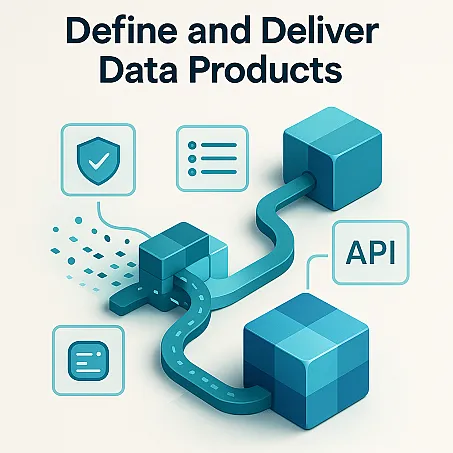Introduction
Data Mesh is a way for organizations to manage data by giving different business teams the power to own and manage their own data. This helps make data more useful, trusted, and available across the company. One of the most important steps in Data Mesh is to define and deliver data products. Clear, well-designed data products help teams get the information they need, when they need it, and make better decisions. Without good data products, even the best data strategy can fall short.
What Does It Mean to Define and Deliver Data Products?
A data product is a set of data that is packaged and shared for others to use. Think of it like a product you buy in a store, but instead of a physical item, it’s a collection of data that is easy to find, understand, and use. For example, a customer data API lets other teams access up-to-date customer information. A sales dashboard is another data product that shows sales numbers in real time.In Data Mesh, each data product is owned by a team that knows the data best. This team is responsible for making sure the data is high quality, well-documented, and safe to use. Treating data as a product means thinking about who will use it, what they need, and how to make it easy for them to get value from it.
Key Activities and Best Practices
- Decide What Data Products Are Needed:
Start by talking to the people who will use the data. Find out what questions they need to answer and what data will help them. Focus on products that will have the biggest impact first.
- Set Clear Standards:
Every data product should have clear rules. This includes service level agreements (SLAs) for how fresh and accurate the data is, metadata that explains what the data means, and APIs that make it easy to access. Good documentation is key.
- Make Data Discoverable and Reusable:
Data products should be easy to find in a data catalog. They should also be built in a way that lets other teams use them for different purposes. For example, a customer data product might be used by both marketing and support teams.
- Build, Test, and Improve:
Build data products in small steps. Test them with real users and get feedback. Use this feedback to make the products better over time. Keep improving documentation and add new features as needed.
- Automate Where Possible:
Use tools to automate data quality checks, updates, and access controls. This saves time and reduces mistakes.
Challenges and Solutions
- Unclear Requirements:
Sometimes, it’s hard to know what users really need.
Solution: Involve users early and often. Ask for feedback and adjust the product as you learn more.
- Poor Data Quality:
If the data is wrong or out of date, people will stop trusting it.
Solution: Set up regular checks for data quality. Fix problems quickly and let users know when issues are resolved.
- Lack of Standards:
Without clear rules, data products can become messy and hard to use.
Solution: Agree on standards for naming, documentation, and access. Make sure every team follows these rules.
- Security and Privacy Risks:
Sharing data can create risks if sensitive information is not protected.
Solution: Set strict access controls and follow company policies for privacy and security. Use automated tools to enforce these rules.
Data Governance Considerations
Data governance is about making sure data is managed well, kept safe, and used properly. In Data Mesh, each team that owns a data product must follow company-wide rules for quality, access, and security. At the same time, there is a central group that sets standards and checks that everyone is following them.
This balance lets teams work quickly while keeping data safe and reliable.Good governance means:
- Every data product has a clear owner.
- There are rules for who can access the data and how it can be used.
- Data quality is checked regularly.
- Documentation is kept up to date.
- Security and privacy are always a priority.
Business and Cultural Impact
Well-defined data products help teams work better together. When data is easy to find and trust, teams can make faster, smarter decisions. This supports business goals like improving customer service, increasing sales, or launching new products. It also builds a culture where teams feel responsible for their data and are proud to share it with others.
A strong data product approach encourages sharing and learning. Teams see the value in making their data useful for others, not just for themselves. Over time, this leads to increased innovation and improved results for the entire company.
Practical Tips and Checklist
Tips:
- Start small with a few high-value data products.
- Involve users early and get their feedback.
- Keep documentation simple and clear.
- Use automation to check data quality and control access.
- Review and improve data products regularly.
Checklist:
- Have you talked to users to understand their needs?
- Is each data product clearly defined and documented?
- Are there SLAs, metadata, and APIs for each product?
- Is the data product easy to find and use?
- Are there regular checks for data quality?
- Are security and privacy rules in place?
- Is there a clear owner for each data product?
- Are you collecting feedback and making improvements?
Conclusion
Defining and delivering data products is a key step in the Data Mesh journey. It turns raw data into something valuable that teams can use every day. By focusing on user needs, setting clear standards, and following good governance, organizations can build data products that drive real business value. This step connects all the others in Data Mesh, helping to create a data-driven culture where everyone can succeed.
